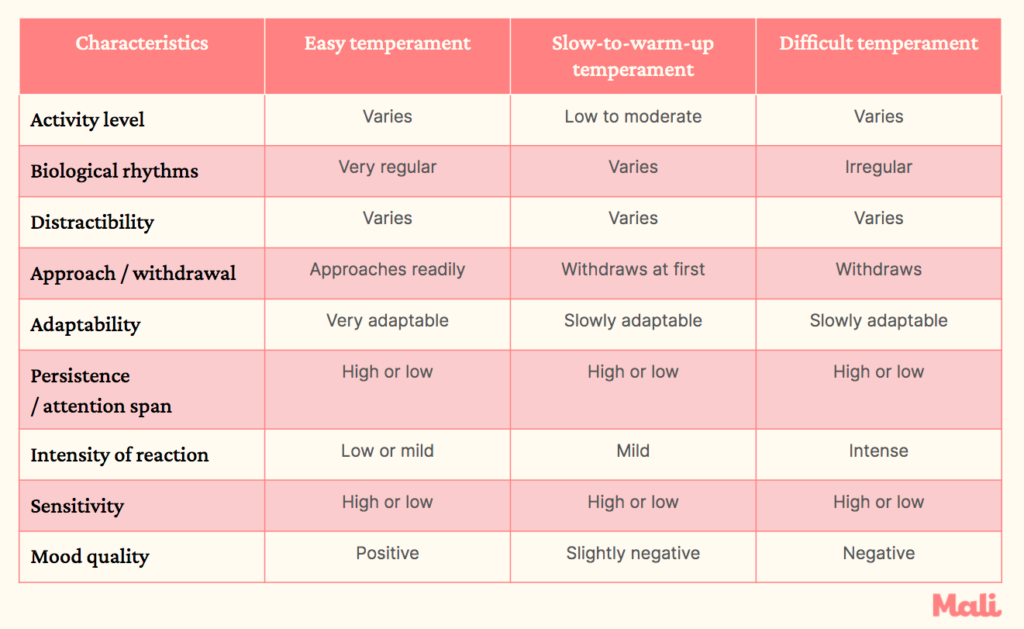Getting to know your child’s temperament
Looking Forward

While some children are predictable, calm, and malleable, others can be more difficult and may not be able to manage their emotional experiences and expressions with ease.
Some psychologists put these differences on temperament.
A short introduction to temperaments
Temperament is a person’s behavioral pattern, inhabited since birth that determines how they react to situations, express themselves, and regulate their emotions. It is the person’s basic natural way of being.
Each baby is born with certain temperamental traits. They express these traits in the way they approach situations, react to interactions, and experience the world around them.
The characteristics of temperament
Psychologists identified nine temperamental traits that a baby can manifest.
- Activity level: Refers to how physically active the baby is
- Biological rhythms: Considers the regularity of the baby’s eating and sleeping routines
- Persistence/attention span: How long the baby can hold on when faced with challenges
- Distractibility: Whether the baby can be easily distracted
- Approach/withdrawal: How the baby responds to new situations, showing enthusiasm or pulling away
- Adaptability: How the baby manages changes in routine, new environment, or recovers from being upset
- Mood quality: How long the baby is in a pleasant, cheerful mood as opposed to fussing, crying, or resisting others
- Sensitivity: How the baby responds to sensory information, including light, sounds, textures, flavors, and smells
- Intensity of reaction: How much energy is involved in the baby’s emotional expressions
Basically, a child will manifest a certain pattern for each trait. For example, the child may be highly active, show intense emotions, be persistent when faced with challenging tasks, and may be less easily distracted.
The major types of temperament and how to deal with them
Psychologists further grouped these nine temperamental traits into three major types or styles of temperament:
Easy (flexible): This is the type of temperament possessed by children who are easy-going, happy, calm, and adaptable. About 40% of children have an easy temperament: they readily approach and easily adapt to new situations, react mildly to things, have a positive overall mood, and are regular in their sleep/wake and eating routines.
Active or feisty (difficult): This type of temperament is seen in children who are very active and fussy and have intense positive or negative reactions. About 10% of children belong to this category. These children tend to withdraw from new situations, and they have intense reactions, irregular routines, and a negative mood. They tend to have long and frequent crying episodes and may also have irregular sleeping and eating habits. Feisty children make parents question their childcare abilities, which is why they are termed “difficult” children in scientific papers. However, they often have valuable traits, such as assertiveness, persistence, and decisiveness.
Slow to warm up (cautious): This temperament type is seen in 5-15% of children. These children withdraw from or are slow to adapt to new things, have a low level of activity, often show a lot of negative emotions, and may be hesitant or fearful in unfamiliar situations. Slow-to-warm-up children may not respond well to changes, such as having a new caregiver or a shift in the daily schedule. They usually prefer to watch a situation for a while before joining in and do not like to be pushed into things. People consider them shy or highly sensitive.
How your reactions matter
As a caregiver, it is your responsibility to understand and adjust to the temperament style of your child. Adjusting your attitude and your expectations based on your understanding of Your Child’s temperament gives rise to what experts call “goodness of fit”.
In other words, you fit yourself to your child — not the other way around. It is you, as an adult, who can and should, based on your knowledge of the child’s temperament and special needs, adjust your expectations of the child and create a suitable environment for the little one to thrive — Your Child is not in a position to adjust the temperament. With your support, your baby will over time understand themselves and be able to manage their temperament to suit the demands of everyday life.
For example, if you understand that Your Child needs to observe the other children in a playground before going to join them, you can provide support by commenting on what the other children are doing while gently urging the little one to go play with them if interested.
Not every child falls neatly into a category
You may think that all children fit neatly into one of the three types of temperament, but that is not the case. In fact, a lot of children have characteristics of more than one of those three major temperament categories.
Thus, it’s better to understand how each child manifests the nine temperament traits so you know their unique needs and behavior. For example, a baby may react intensely and yet be very regular in their sleep/wake and feeding routine. The table below shows the relationship between the temperamental traits and the different temperament styles.

Verified:
Ketsupa Jirakarn (Mental health specialist) (1 July 2022)



